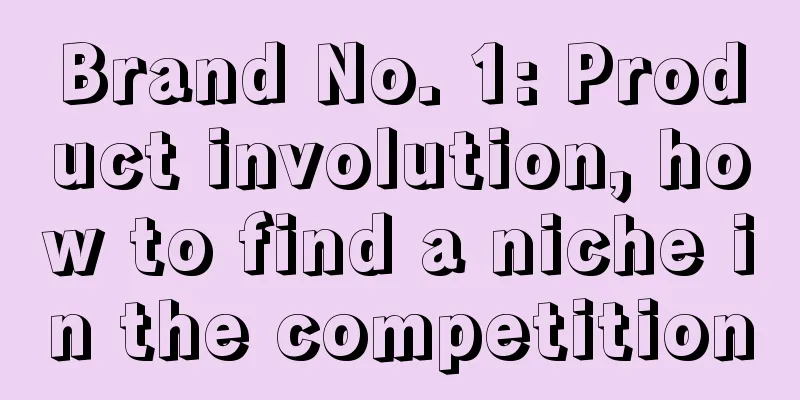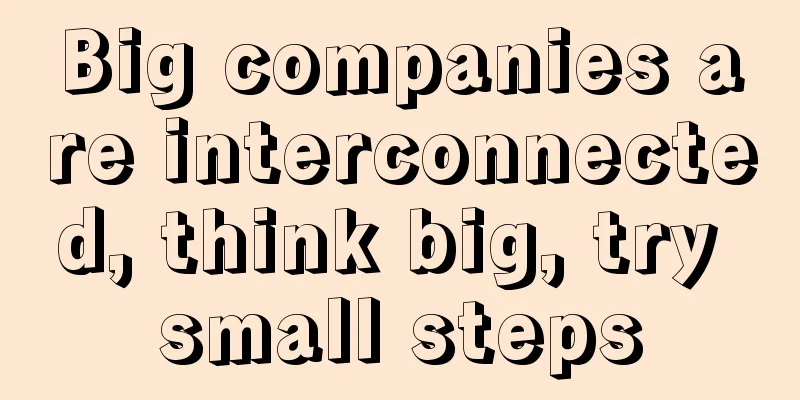Brand No. 1: Product involution, how to find a niche in the competition

1. Product Involution: The Same Value of CognitionTo explain the issue of product involution, we must first start with categories and cognition. 1. Consumers think in categories and express themselves in brandsThis is the ultimate and initial value. To be precise, there are two situations: when there is no brand, consumers express their demand through categories (give me a glass of water); when there is a brand, consumers express their demand through brands (give me a bottle of Nongfu Spring). The insight into demand lies in the daily, colloquial expressions of consumers. The insight into the daily expressions of consumers’ demand is the source code of the marketing foundation. This source code determines how you understand marketing and how you do marketing—marketing starts with people and ends with demand. 2. The basic unit of memory is categoryYou can think of consumers' memory of brands as small drawers. Different types of brands are put into different small drawers, and the classification label of the small drawer is category. A small drawer (category) can only hold (remember) 7-9 brands. Memory is based on category, and the upper limit is 7-9 brands. If there are more than that, it is difficult to remember, so the key is to count the best. 3. Six basic characteristics of the mindThese six basic characteristics are the core of understanding consumer minds and even the key to positioning.
Therefore, it corresponds to the six basic principles of our branding:
To achieve distinctiveness, it is necessary to break through the threshold of consumer cognition, so as to achieve the effect of cognitive differentiation. Now everyone is talking about corporate involution, what is involution? In fact, isn’t the core of involution the homogeneity of products? In fact, it is not the homogeneity of products, but the homogeneity of consumers’ perception of products. In other words, the threshold of cognition has not been broken, and it is not unique enough. How to effectively break through the threshold is to start a new business, to be innovative; to create new species, new categories (this is first-level efficiency), because: "The difference between species is huge"; new species naturally come with new cognition. Of course, we need not only to understand, but also to have a deep understanding from the perspective of categories and differentiation: Why are categories powerful? 2. What is a category?Category refers to the classification, storage and naming of relevant information by consumers. The value to business lies in classification, storage and naming. A name is a classification, and a classification represents a consumer demand. Classification, storage and naming directly affect consumers' purchasing choices. Consumers express their needs through categories and choose products through brands. Whether it is Coke or Sprite, Starbucks or Didi, the entire value of a brand lies in whether your brand is used to express the needs when consumer needs arise. Either create a new category or differentiate an old category The underlying logic of unchanged categories is that the value of connecting to customer needs remains unchanged - categories connect to needs, consumers think in terms of categories and express themselves with brands - have a bottle of Coke, drink some Starbucks, take a Didi. Coke = Coca-Cola, Starbucks = coffee, Didi = taxi, and brands occupy (represent) categories, which is the shortest path to grasp the underlying needs of consumers. Brands are the tip of the iceberg, while categories are the entire iceberg - only by understanding categories can we better understand business. Three logics of categories: Category is not the cause, but the result: the category a new brand chooses to enter largely predicts the result - old products are redundant and innovation makes sense. Category is the matrix: consumers use categories to match their demands, use categories to express their demands, and use brands to choose products. Innovative sub-categories are the crudest and most direct way to express differentiation. Insights into the differentiation of existing categories: A deep understanding of categories is the basis for category differentiation. Category is the consumers’ colloquial expression, matching and expressing demands. The value of branding lies in the fact that brand = category. The faster this equal sign is drawn, the more valuable it is. 3. How to understand differentiationDiscovering and selecting category opportunities is an entrepreneur’s primary business decision. Category differentiation brings new market space, and differentiation is the driving force of business development. Starting a war in a highly competitive price range is obviously unwise and requires more resources. New media produces new content, new content brings in new crowds, and new crowds trigger new brand opportunities. Category differentiation brings new market opportunities: It is easier to create new brands in the process of category differentiation. Only new categories can bring new cognition, and new cognition brings new brand opportunities - 80% of business decisions come from how you discover new opportunities for category differentiation. Most of the new brands that emerged in the three years from 2019 to 2021 were based on the differentiation of categories. Differentiated from the traditional cereal category, there is cereal with freeze-dried fruits, Wang Baobao cereal. From the traditional bird's nest category, it has differentiated into fresh stewed bird's nest and Xiaoxian stew. Different from the traditional braised chicken feet, the tiger skin chicken feet, which are more delicious after frying, are Wang Xiaolu. The origin of demand has never changed, only the way to meet demand has changed. New category opportunities or category characteristic opportunities are new brand opportunities. The power of "differentiation" makes the world colorful. Everything in the world originates from "differentiation", and "differentiation" is the inevitable trend of species development (The Origin of Species). Three logics:
Escape from involution and focus twice: Strength (product strength ); clarity (consumer) The bottom layer of collective unconsciousness is manifested in economy, culture, and humanities, and is buried in the unchanging DNA and source code that makes people human. What is this DNA and source code? Hegel believed that the most fundamental driving force behind the development of human history is psychology, which is the desire of people and mankind to be "recognized". First, "Positioning": The ultimate competition is in the mind, and brand is a tool to occupy the mind. On this basis, there are three basic positioning principles:
Next is Business War: Four Basic Models
The four basic business war models are based on competitors. This is what Sun Tzu said in the Art of War: Know yourself and know your enemy, and know your enemy (competitor). Therefore, the premise of positioning is based on competition. Great enemies lead to great achievements. Who are our enemies and who are our friends? This is the main issue of the revolution. The primary issue of the enterprise competition growth revolution is - vacancy. Then there is "Focus": All strategies inevitably involve trade-offs. The core of strategy is not war, but first of all strategic negligence. That is, only by not doing something can you do it well; by not doing something, you will have more energy to specialize in something, do it well, and do it thoroughly. By focusing on externally, you can occupy the "first place" and establish a sense of advantage; internally, you can multiply by subtraction and concentrate superior resources. Then the question is, focus, focus - to what extent can we find the focus. For example: Fotile focused on high-end kitchen appliances and beat Siemens; Robam focused on strong suction and beat Fotile. On the one hand, too much is as bad as too little; on the other hand, if you take a hundred steps, you will only get halfway through, and you will not finish the journey at all. This involves the question of the degree of focus. I think there are probably three aspects to the degree of focus:
The essence of discussing the degree of focus is to return to the consumer side, because the core result of positioning is that the brand has a cognitive advantage. Therefore, the criterion for judgment is whether the company's focus has formed a clear, specific and concrete cognitive advantage on the consumer side. For example: when XX brand is mentioned, XX product comes to mind; when XX product is mentioned, XX brand comes to mind first. From XX brand to XX product, and from XX product to XX brand, this unconscious reaction of consumers is the evaluation and quantity of degree. If you are afraid of getting angry, drink Wanglaoji. Finally, it comes down to "The Origin of Brands": Why is it the origin of brands? Because it answers the essential question and the ultimate question of brands - the parasitic matrix of brands is categories. The strength of brands is due to the matrix (categories), and the demise of brands is also due to the decline of the matrix (categories). You have to find the Mayflower to discover the New World, not the Titanic. This involves the understanding of form and momentum. Brand is form, category is momentum. A good fighter seeks momentum, and this momentum is the category bonus and the vitality of the category; this momentum is the force of brand awakening. We did nothing wrong, but we lost - Nokia. Nokia lost because of the demise of the feature phone category, of course, Motorola, Ericsson, and Blackberry. When someone loses, someone else wins. Apple won (new generation of smartphones) and won a great victory; Xiaomi won (direct sales smartphones) and Huawei won (first choice for business people). From feature phones to smartphones, foldable screens are another new opportunity. The strength of a brand lies in the replacement and iteration of its categories. Therefore, creating and leading a new category is the first choice of brand strategy or the best practice of brand strategy, because it finds a vacant position. Therefore, the degree of focus at this level can be understood as focusing on a clear, specific, and concrete category in the minds of consumers. Of course, it is necessary to distinguish between true categories and false categories; concrete categories and abstract categories. The core of the degree of strength is to form a clear cognition among consumers - occupying a vacant position. Therefore, the degree of focus is strength (product strength) and clarity (consumers). Strength refers to whether the company can release the energy of focus by multiplication after subtraction, and the other is to release the clarity of cognition on the consumer side. The clearer the clarity, the more powerful the vacancy will be. Author: Houshan Keju, Source: WeChat public account “Lao Gao Business and Brand”. |
<<: 10 ways to attract private traffic to physical stores
>>: 3 secrets hidden in “competition and demand”!
Recommend
What is Amazon SD advertising? How to open it?
There are three types of Amazon ads: sp ads, sb ad...
Does Shopify need to ship abroad first? Does Shopify ship by itself?
Shopify is an independent website. This platform i...
With millions of paid members and a repurchase rate of up to 60%, what makes "Super Monkey", the new darling of the fitness industry, keep users paying for it?
Fitness is a hot demand nowadays. As a fitness bra...
What are the cross-border third-party payment platforms? Which one is better?
When people shop on cross-border e-commerce platfo...
Those new consumer brands that were once popular but are now miserable
New consumer brands once quickly became popular th...
Even if Cook comes, we have to buy goods. Huaqiangbei's "new specialty" is popular on Xiaohongshu
This article delves into how Huaqiangbei’s innovat...
What is the process for opening a store on Amazon? Can an individual open a store on Amazon?
As one of the world's largest e-commerce platf...
What is the formula for Amazon ad click-through rate? Why is it so low?
Now you can learn about Amazon advertising. When y...
Which categories on Amazon are easy to get orders from? Which categories are more popular?
On Amazon, a huge e-commerce platform, Amazon sell...
In the 50 billion short drama arena, the first person to pay will be the first to admit defeat
Watching short plays is like eating sunflower seed...
What are the requirements for participating in Amazon Black Friday?
The Double 11 event in China has already started, ...
With 5 million followers and a variety show appearance, the actor of the hit short drama "became famous in a roundabout way"
This article deeply analyzes how short plays have ...
What to do if Amazon's new products have no natural traffic? How to deal with it?
After launching new products on Amazon, many merch...
How can I have my own methodology when working in a small factory?
Students working in small factories always envy th...
How much does it cost to sell on Amazon? How much do I need to prepare?
It is relatively simple to open a store on Amazon....









